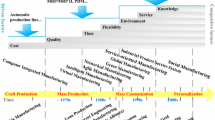Abstract
This paper deals with competition diffusion of multiple-advanced manufacturing modes in a cluster environment, to reveal the competition diffusion rules of the advanced manufacturing mode. First, the influencing factors on advanced manufacturing mode diffusion in a cluster environment are analysed. Second, the diffusion properties and the diffusion mechanism are analysed, and the competition diffusion model of multiple-modes is established. Third, the model is analysed and the qualitative results are presented. Finally, the application of the diffusion model is exemplified and simulated (by matlab 7.1), producing results that are consistent with qualitative analysis that also verifies the correctness of the model. In addition, the influence of the cluster environment is discussed. The diffusion model helps enterprises understand the diffusion rules of the advanced manufacturing modes and provides a decision-making basis for enterprises and government.





Similar content being viewed by others
References
Bass FM (1969). A new product growth model for consumer durables. Management Science 15 (5): 215–227.
Chun SY and Hahn M (2008). A diffusion model for products with indirect network externalities. Journal of Forecasting 27 (4): 357–370.
Dong DM and Guo CJ (2009). The application of CIMS to high speed wire rod mill of Tangshan Iron & Steel Group Co., Ltd. Journal of Tangshan College 22 (6): 80–83 (in Chinese).
Long L (2004). Integration of CIMS and the optimization of contemporary integrated manufacturing system. Electronic Science and Technology (1): 51–53, 64 (in Chinese).
Mengoni M, Germani M and Mandorli F (2009). A structured agile design approach to support customisation in wellness product development. International Journal of Computer Integrated Manufacturing 22 (1): 42–54.
Oborski P (2004). Man-machine interactions in advanced manufacturing systems. International Journal of Advanced Manufacturing Technology 23 (3–4): 227–232.
Ren CF et al (2006). 2006 China Industrial Economy Statistical Yearbook. China Statistics Press: Beijing (in Chinese).
Rogers EM (1995). Diffusion of Innovations, 4th edn. The Free Press: New York.
Satoh D (2001). A discrete bass model and its parameter estimation. Journal of the Operations Research Society of Japan 44 (1): 1–18.
Steffens PR (2003). A model of multiple-unit ownership as a diffusion process. Technological Forecasting and Social Change 70 (9): 901–917.
Sun LY and Wang J (2001). The conception, characters and classification of advanced manufacturing modes. Journal of Xi’an Jiaotong University (Social Sciences) 21 (2): 27–31, (in Chinese).
Sun LY, Wang J and Cao DB (2002). Study on the classification of advanced manufacturing modes. China Mechanical Engineering 13 (1): 84–88 (in Chinese).
Sultan F, Farley JU and Lehmann DR (1990). A meta-analysis of applications of diffusion models. Journal of Marketing Research 27 (1): 70–77.
Tsai CS (2002). Evaluation and optimisation of integrated manufacturing system operations using Taguch's experiment design in computer simulation. Computers & Industrial Engineering 43 (3): 591–604.
Xue CG and Cao HW (2008). Research on diffusion behavior of the computer integrated manufacturing philosophy. Proceedings of the Institution of Mechanical Engineers Part B—Journal of Engineering Manufacture 222 (8): 1025–1032.
Xue CG and Cao HW (2011). Competition and diffusion of an advanced manufacturing mode under the government influence. Journal of Systems & Management 20 (3): 370–375 (in Chinese).
Yan HS and Ma KP (2011). Competitive diffusion process of repurchased products in knowledgeable manufacturing. European Journal of Operational Research 208 (3): 243–252.
Zhang B, Yang GY and Rong GH (2002). Applications of diffusion models for internet consumer analysis. Chinese Journal of Management Science 10 (2): 51–56 (in Chinese).
Zhang L and Lu YL (2009). Study on the diffusion model of fast moving consumer goods—Taking Chinese dairy products as examples. Forecasting 28 (1): 30–35 (in Chinese).
Zheng JJ and Tang P (2008). Analysis of innovative technology diffusion dynamic model of high-tech enterprise. In: Proceeding of the 2008 Chinese Control and Decision Conference (CCDC 2008). IEEE, New York, pp 1119–1122.
Acknowledgements
This research is supported by the National Natural Science Foundation of China under Grant numbers 70901066 and 70971119, and the 2011 Graduate Science Research Foundation of Zhengzhou University under Grant number 11L01402. We thank the anonymous referees for their valuable comments and suggestions.
Author information
Authors and Affiliations
Rights and permissions
About this article
Cite this article
Xue, C., Liu, J. & Cao, H. Research on competition diffusion of the multiple-advanced manufacturing mode in a cluster environment. J Oper Res Soc 64, 864–872 (2013). https://doi.org/10.1057/jors.2012.91
Received:
Accepted:
Published:
Issue Date:
DOI: https://doi.org/10.1057/jors.2012.91




